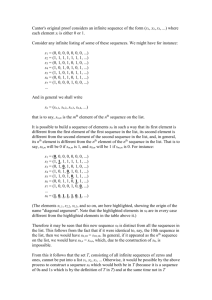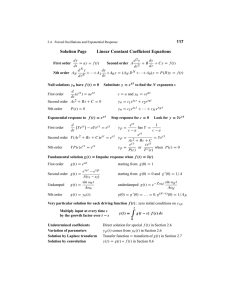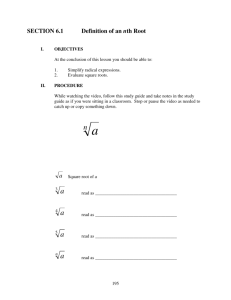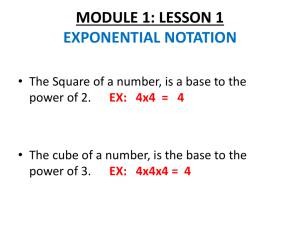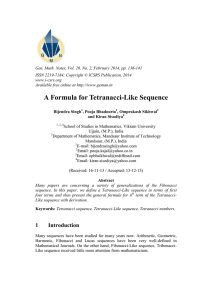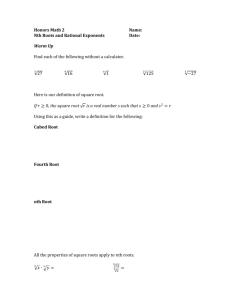Gen. Math. Notes, Vol. 17, No. 1, July, 2013, pp.... ISSN 2219-7184; Copyright © ICSRS Publication, 2013
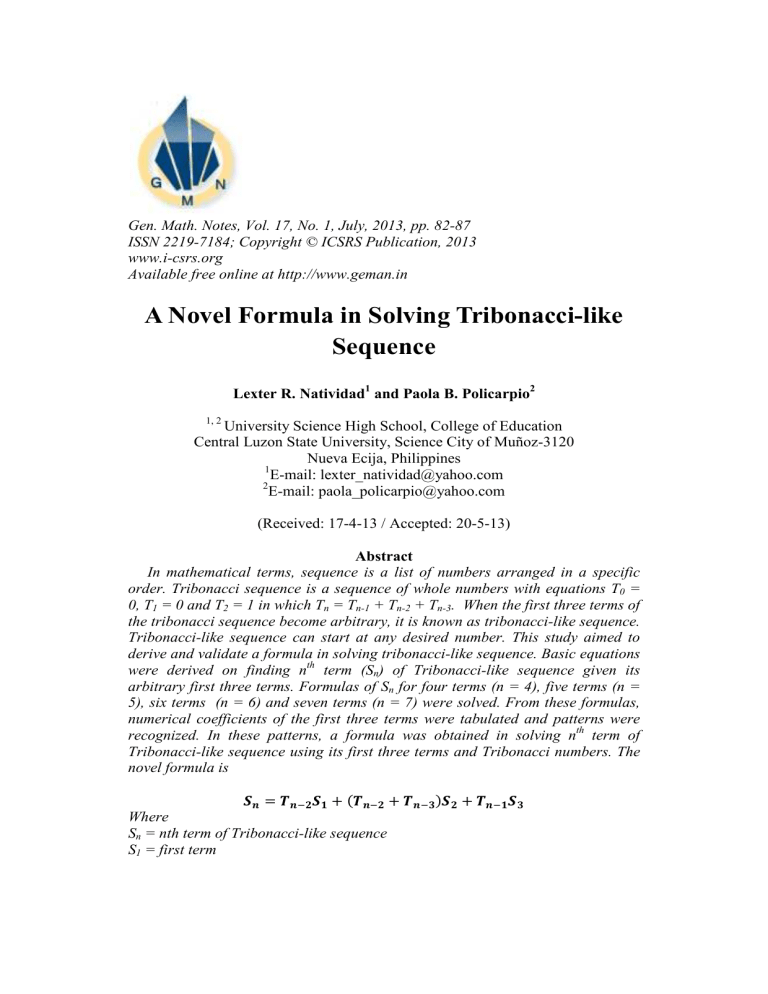
Gen. Math. Notes, Vol. 17, No. 1, July, 2013, pp. 82-87
ISSN 2219-7184; Copyright © ICSRS Publication, 2013 www.i-csrs.org
Available free online at http://www.geman.in
A Novel Formula in Solving Tribonacci-like
Sequence
Lexter R. Natividad
1
and Paola B. Policarpio
2
1, 2
University Science High School, College of Education
Central Luzon State University, Science City of Muñoz-3120
Nueva Ecija, Philippines
1
E-mail: lexter_natividad@yahoo.com
2
E-mail: paola_policarpio@yahoo.com
(Received: 17-4-13 / Accepted: 20-5-13)
Abstract
In mathematical terms, sequence is a list of numbers arranged in a specific order. Tribonacci sequence is a sequence of whole numbers with equations T
0
=
0, T
1
= 0 and T
2
= 1 in which T n
= T n-1
+ T n-2
+ T n-3
. When the first three terms of the tribonacci sequence become arbitrary, it is known as tribonacci-like sequence.
Tribonacci-like sequence can start at any desired number. This study aimed to derive and validate a formula in solving tribonacci-like sequence. Basic equations were derived on finding n th
term (S n
) of Tribonacci-like sequence given its arbitrary first three terms. Formulas of S n
for four terms (n = 4), five terms (n =
5), six terms (n = 6) and seven terms (n = 7) were solved. From these formulas, numerical coefficients of the first three terms were tabulated and patterns were recognized. In these patterns, a formula was obtained in solving n th
term of
Tribonacci-like sequence using its first three terms and Tribonacci numbers. The novel formula is
= + +
Where
S n
= nth term of Tribonacci-like sequence
S
1
= first term
+
A Novel Formula in Solving Tribonacci-Like… 83
S
2
= second term
S
3
= third term
T n-1
, T n-2
, T n-3
= corresponding Tribonacci numbers.
Keywords: Tribonacci sequence, Tribonacci-like sequence, Tribonacci
numbers.
1 Introduction
Sequence is a list of numbers arranged in a specific order. It can contain members similar to a set. However, sequence can have the same members repeated as much as possible at a divergent locations. Thus, pattern is a substantial element of a sequence.
There are lots of functional sequences existing today. Some sequences like of arithmetic, geometric, square, cube, Lucas, Fibonacci and Tribonacci are known to many for a very long time. Arithmetic, geometric, harmonic and fibonacci sequence have an established formula on finding the sum and the n th
term of the respective sequences. However, devising formula for the n th
term of fibonaccilike, tribonacci-like and other related sequences have received little attention from mathematicians.
Fibonacci sequence is a sequence starting from 0 and 1 where the succeeding terms are taken from two previous terms that are added. Moreover, fibonacci-like sequence is a derivative of the fibonacci sequence where the same pattern is applied. Their only difference is that Fibonacci-like sequence starts at any two given terms.
Recently, a formula derived by Natividad [1] in solving a Fibonacci-like sequence was established through amalgamating basic formula from important patterns with a Binet’s formula. The resulting equation is
=
−
− 1 −
√5
− 1 −
√5
, ≥ 1.
On the other hand, Tribonacci sequence is a sequence of whole numbers with equations T
0
= 0, T
1
= 0 and T
2
= 1 in which T n
= T n-1
+ T n-2
+ T n-3
. This only means that the previous three terms are added to find the next term. It is also referred as series of Tribonacci numbers.
Noe, Piezas, and Weisstein [2] listed two explicit formulas for Tribonacci sequence. The implicit formula is
84 Lexter R. Natividad et al.
=
− − + − − + where
, "
are the three roots of the polynomial
− −
# − $ − − 1
.
They gave also another explicit formula in the form of
= %3
'13 19 + 3√33 # + 13 19 − 3√33
586 + 102√33
$ #.
# + 13) 586 + 102√33
+ 4 − 2 586 + 102√33
#.
#.
%.
Just like fibonacci and fibonacci-like sequence, when the first three terms of the tribonacci sequence become arbitrary, it is known as tribonacci-like sequence. tribonacci-like sequence can start at any desired number. These sequences have many applications in environment, biology, chemistry, arts, mathematics, music and among others as it occurs naturally.
However, to the best knowledge of the researchers, there are no equations have been formulated on finding the n th
term of the Tribonacci-like sequence. Thus, this study will present how to derive a formula on finding n th
term of the
Tribonacci-like sequence using recognition of patterns and by observing its first three terms.
2 Main Results
Tribonacci sequence, like Fibonacci, is a sequence where terms are obtained from adding previous three terms. The first three terms of this sequence are 0, 1, and 1.
From this definition, we can define Tribonacci-like sequence as a Tribonacci sequence where the first three terms are arbitrary.
These first three terms of Tribonacci-like sequence can be designated as
0 , 0
In this manner, a formula was obtained for
0
given the first three terms.
$
, 0
# .
Definition 1: The sequence
0 , 0
$
, 0
#
, … , 0
in which
0 = 0
#
+ 0
$
+ 0 is a generalized tribonacci sequence (tribonacci-like sequence). This sequence
follows the pattern of tribonacci sequence.
Considering the Tribonacci-like sequence
0 , 0
$
, 0
#
, … , 0
, a novel formula for n th term of tribonacci-like sequence was derived. Formula was obtained from the first, second and third terms designated as S
1
, S
2
and S
3
only. Specific formula was observed and from these, general formula was deduced.
To find the general formula for the n th
term of the Tribonacci-like sequence, a pattern was recognized. All the equations derived were listed to find recognizable patterns easily.
A Novel Formula in Solving Tribonacci-Like… 85
0
4
0
5
0
3
0
2
= 0
= 20
+ 0
= 0 + 20
$
+ 30
= 40 + 60
$
$
+ 0
#
+ 20
#
+ 40
+ 70
#
#
After careful observation and investigation, all the numerical coefficients for S
1
,
S
2
and S
3
were tabulated as shown in Table 1.
Table 1: Coefficients of S
1
, S
2
, and S
3
of n th
term of Tribonacci-like Sequence
Number of
Terms n th
term of
Tribonacci-like sequence
Coefficient
S
1
S
2
S
3
4
5
6
7
.
.
. n
.
.
S n
S
4
S
5
S
6
S
7
.
1
1
2
4
$
.
.
.
$
1
2
3
6
.
.
.
+
#
1
2
4
7
.
.
.
It can be noted that coefficients of S
1
and S
3
follows the Tribonacci sequence
(Table 2).
Table 2: The first 18 Tribonacci Numbers
Nth Term
4
5
6
7
1
2
3
8
9
10
11
12
13
Tribonacci Number
2
4
7
13
0
1
1
24
44
81
149
274
504
86 Lexter R. Natividad et al.
14
15
16
17
18
927
1705
3136
5768
10609
From these observations, the following theorem is proposed.
Theorem 1: For any real numbers S
1
, S
2
, and S
3
, the formula for finding n th term of tribonacci-like sequence is
= + + + where S n
is the nth term of tribonacci-like sequence, S
1
is the first term, S
2
is the second term, S
3
is the third term and T n-1
, T n-2
and T n-3
are the corresponding
tribonacci numbers.
Proof: We will prove the formula for Tribonacci-like sequence for n ≥ 4
0 =
$
0 +
$
+
#
0
$
+ 0
#
The formula is true for n=3, n=4, n=5 etc. which is easy to verify.
Using n=4,
0
2
=
$
0 +
$
+ 0
$
+
#
0
#
From table 2,
0
2
= 10 + 1 + 00
$
0
2
= 0 + 0
$
+ 0
+ 10
#
# which is true from the definition of tribonacci-like sequence.
Next, we will show that the formula is valid for n is greater than 4. Assuming that
P(k) is true and writing it as
0
7
=
7$
0 +
7$
+
7#
0
$
+
7
0
#
Suppose we want to find the k+1 term of the sequence, so
0
7
=
7$
0
7
0
=
+ 8
7
7$
+
0 +
7
7#
+
7$
90
$
0
$
+
7
+
7
0
#
0
#
To verify, we will provide the assumption of P(k) implies the truth of P(k+1). To do so, we will add
0
7$ to both sides of P(k). The left side of P(k) will become
7 and
0
0
7$
+ 0
7
+ 0
7
A Novel Formula in Solving Tribonacci-Like… 87 which is equal to the left side of P(k+1) since
0
7$ definition of Tribonacci-like sequence.
+ 0
7
+ 0
7
= :
7
After adding
0
7 and
0
7$ , the right side of P(k) will become
7$
0 +
( 7$
+
7#
0
$
+
7
0
#
+ 0
7$
+ 0
7
from
But since
7#
0
7$
=
72
+
72
0
$
0 +
72
+
7$
0
+
#
73
0
$
+
7#
0
# and
0
7
=
7#
0 +
The equation will become
0
7
7#
=
0
#
7$
0 +
7$
+
7#
0
7#
= (
73
]0
$
+
+
7#
72
0
0
$
$
+
+
+
+
7
7#
+
+
7$
72 )
0
+ [(
+
7#
0
#
7
7$
7$
0
#
0
#
+
+
7#
72
0 +
+
72
72
+
+
7#
73
+
0
$
72
+
+
From the definition, the equation will become
7
0 +
7
+
7$
0
$ which is the right side of P(k+1).
+
7
0
#
Through strong mathematical induction, conclusion follows.
Conclusions
It is concluded that patterns are essential in deriving formulas for sequences.
Using these patterns, a formula was obtained in solving n th
term of tribonacci-like sequence using its first three terms and tribonacci numbers. The formula will be of great help for other people establishing new formula for other equations that receive little attention. The derived formula for solving the n th
term of a tribonacci-like sequence was verified in real numbers system by testing the formula in different examples and was verified through mathematical induction.
References
[1] L.R. Natividad, Deriving a formula in solving Fibonacci-like sequence,
International Journal of Mathematics and Scientific Computing, 1(2010),
19-21.
[2] T. Noe, T. Piezas and E. Weisstein, Tribonacci Number, Retrieved from http://mathworld.wolfram.com/TribonacciNumber.html, September 30
(2012).

